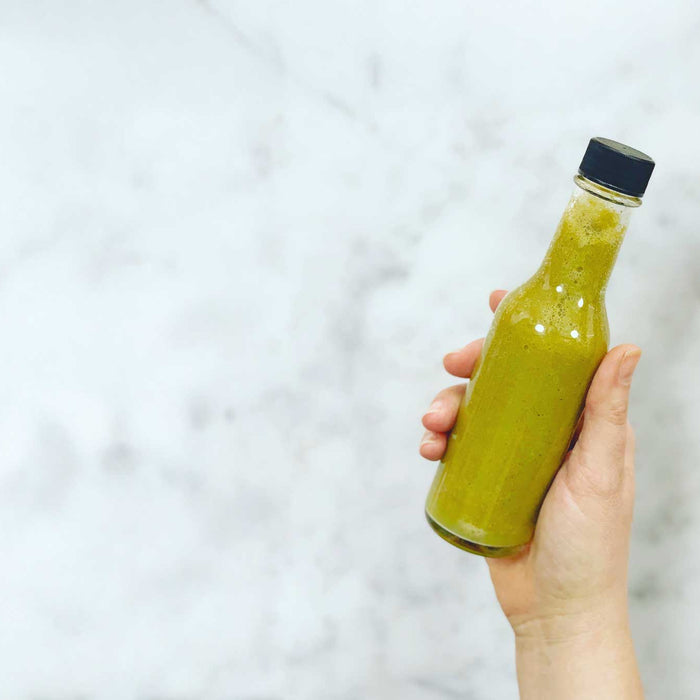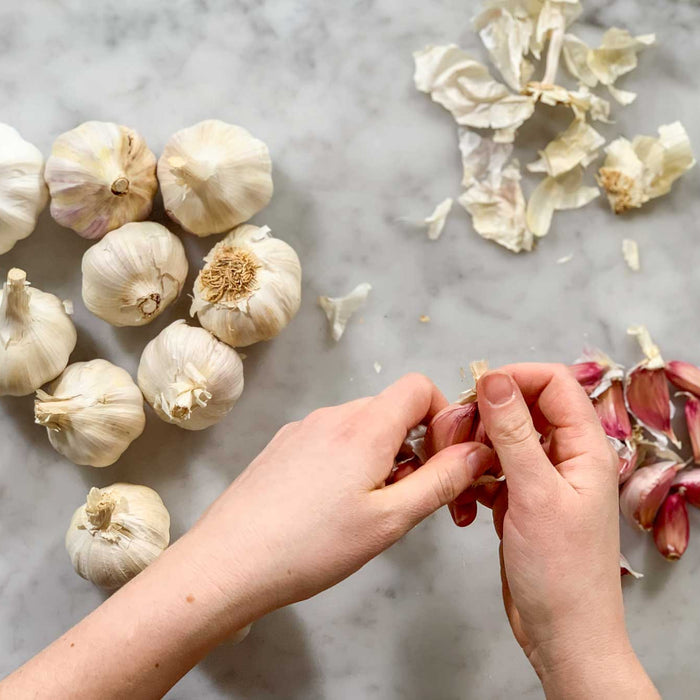
Joshua McFadden's Butternut Squash with Sausage, Sage & Spicy Chiles from Six Seasons of Pasta
A handmade casarecce recipe from Joshua McFadden’s Six Seasons of Pasta, featuring a silky butternut squash, sausage, and sage sauce.

We adore honey. We adore garlic. And while we mix them together all the time—in marinades, sauces, and drizzled over some truly drool-worthy pizzas—fermenting them together creates something entirely different and incredibly special. This isn’t just infused honey. It’s a whole new flavor profile.
As the garlic slowly ferments in the honey, the honey thins out and takes on bold, savory garlic flavor. It becomes beautifully runny—perfect for drizzling over roasted vegetables, cheese boards, and yes, more pizza. But it’s not just the honey that changes. The garlic cloves themselves transform too, losing their sharp bite and turning mellow, sweet, and deeply flavorful.
We use the fermented honey like a finishing sauce and treat the garlic cloves as a star ingredient all their own—studded into focaccia, sliced into pasta sauces, or minced into marinades and dressings. Fermented honey garlic is simple, wildly flavorful, and one of those fermentation recipes you’ll find yourself making again and again.
So, how do you make fermented garlic honey?
Fermented garlic honey is one of the easiest ferments to make, with the most tedious task probably trying to get all those garlic cloves peeled. You will need a glass jar, two heads of garlic and one cup of local honey (you’re looking for raw, unpasteurized honey) to cover your garlic cloves.
It is important to note that honey has a really low water content and naturally antibacterial properties. This means that it can kill off wild yeasts and bacteria from the environment. By crushing the garlic cloves slightly and allowing them to release their juices in the honey, the antibacterial properties become less potent and the fermentation process can start. The honey will start to foam and become runnier as it begins to ferment and infuse with the rich flavors of garlic. Fermented garlic honey will take about a month before it is ready to eat and can be left up to twelve months in a cool, dark cupboard.
This process differs in a few key ways from most of our fermentation recipes. We recommend using a 16 ounce jar instead of your 1/2 gallon FarmSteady fermenter (because it would be quite a bit more honey to fill). But you can absolutely scale it up (and once you’ve had a taste of this, you will likely want to). We also don’t use a fermentation weight (it would just get covered in honey) or airlock, and we instead recommend that you turn over your jar every day or two to re-coat the garlic cloves, and loosen the lid periodically to release any built up CO2. And lastly, we don’t ever move this to the fridge. Honey and refrigeration don’t go well together. So this is one ferment that you will keep at room temperature the whole time.
Fermented garlic honey should become a staple in your home. It’s really easy to make, will elevate the flavor of even the most tried and true dishes and can be your secret immune-boosting and cold-fighting weapon. Try it, and you’ll always need a jar on hand.
Uses and health benefits of fermented garlic honey
Fermented garlic honey has a sweet but savory taste. It can be used as a marinate for meat and poultry dishes, or as a drizzle for vegetable bakes (think roasted pumpkin and butternut). When mixed with a bit of olive oil, it makes a perfect salad dressing, especially where fruits like figs or dried apricots are featured in the salad. You can also drizzle it over herby breads or crispy bacon, and it is absolutely amazing on pizza.
Both honey and garlic have well-known health benefits. Unpasteurized raw honey is packed with antioxidants that protect and strengthen the immune system and has antibacterial and antiseptic properties. In ancient times it was used as a traditional medicine to help heal wounds and as a remedy for sore throats and coughing. Honey can also be used as a natural sugar alternative.
Garlic is an ingredient found in most cuisines around the world. It contains high levels of sulfur, amino acids, flavonoids and allicin. Allicin is the compound that gives garlic its antibacterial and antiviral properties, making it quite a potent immune booster and cold and flu fighter. Some folks swear by eating a clove of fermented honey garlic when the onset of a cold is detected. While it can’t protect you from germs or viruses, it can help alleviate those dreaded cold and flu symptoms and soothe a cough and scratchy throat.
FarmSteady started with a simple idea: make projects like this easier to jump into.
$40.00
More about this kit →
A handmade casarecce recipe from Joshua McFadden’s Six Seasons of Pasta, featuring a silky butternut squash, sausage, and sage sauce.

Hot sauce probably isn’t the first thing that comes to mind when you think of honeydew melon. Honeydew is fresh, sweet, and cooling... everything that hot sauce usually isn’t. But that contrast is exactly what makes this recipe so special....

Fermented garlic is the flavor upgrade your kitchen has been waiting for—bold, deeply savory, and bursting with rich umami flavor. Not only does lacto-fermenting garlic mellow out its sharp bite, but it also creates a versatile, ready-to-use condiment that instantly...
Comments
Leave a comment